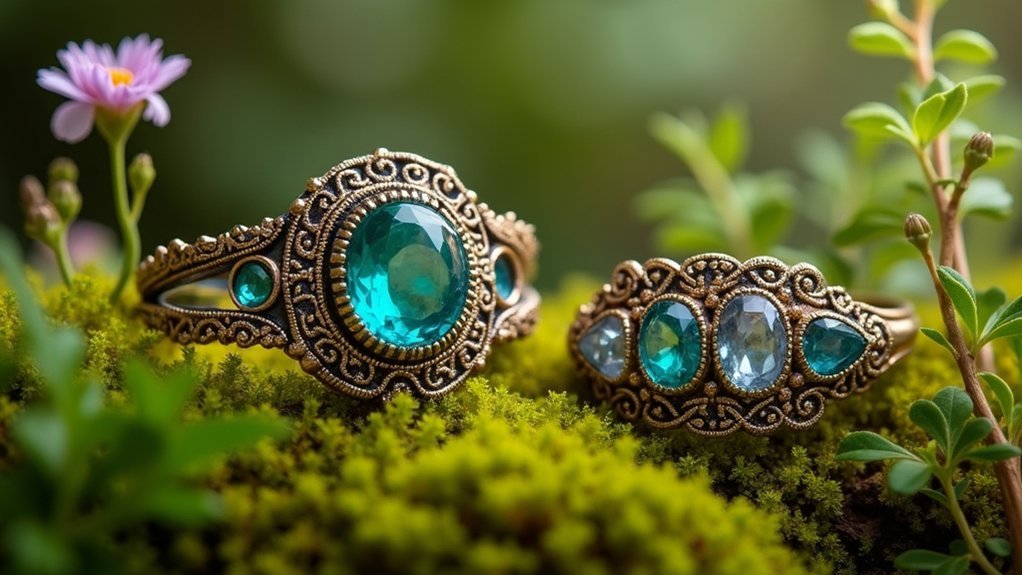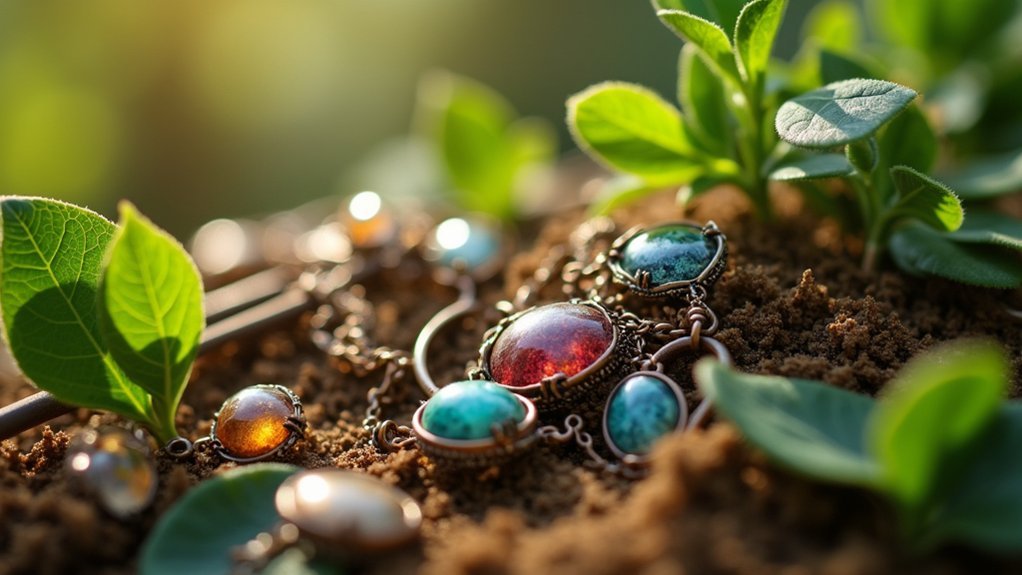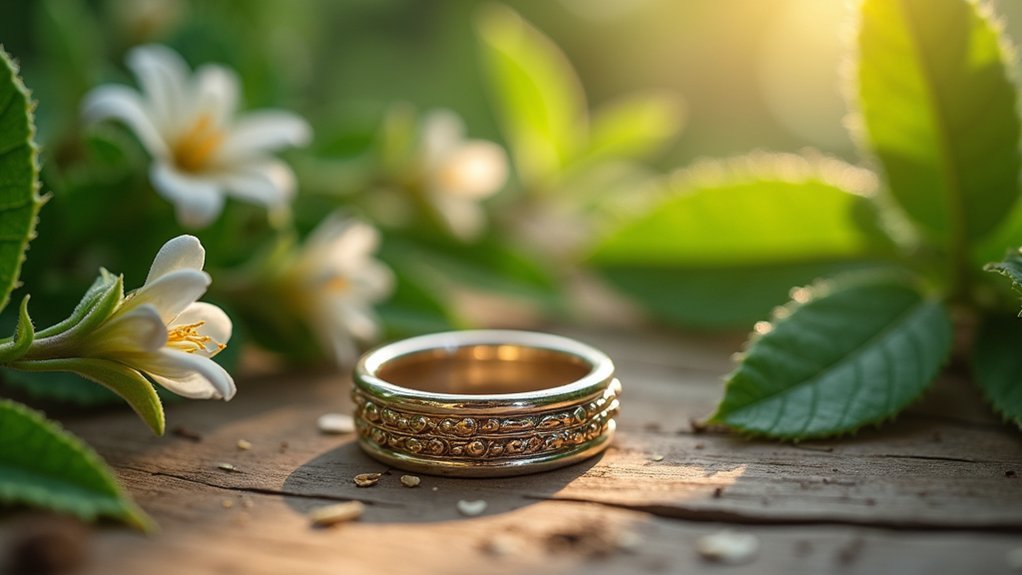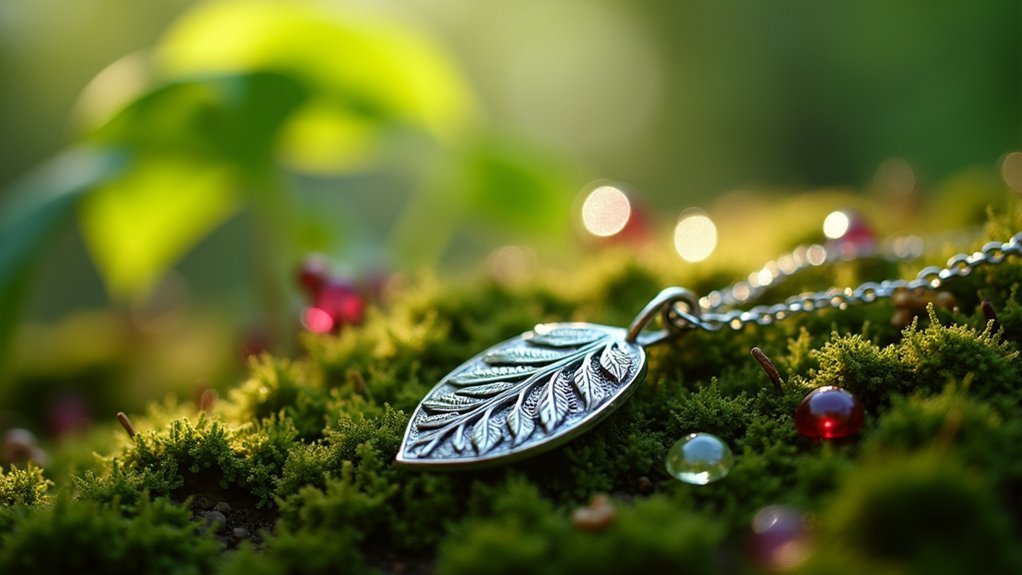You’ll benefit from choosing eco-friendly jewelry business models because they reduce operational costs through recycled materials and energy-efficient production while tapping into a rapidly growing market. With 66% of consumers willing to pay premiums for sustainable brands and the market expanding at 27% annually, you’ll access higher profit margins and build stronger customer loyalty. Ethical sourcing practices create transparent supply chains that differentiate your brand and foster long-term relationships with conscious consumers who value accountability and environmental responsibility.
Environmental Benefits of Sustainable Jewelry Manufacturing

While traditional jewelry manufacturing devastates ecosystems through intensive mining operations, sustainable jewelry production offers a powerful alternative that protects our planet’s most vulnerable environments.
Sustainable jewelry production serves as a vital shield against the environmental destruction caused by traditional mining practices.
When you choose sustainable practices, you’re supporting brands that use recycled metals and lab-grown diamonds, greatly reducing the need for destructive mining that causes deforestation and habitat destruction.
You’ll also find that these eco-friendly approaches address critical environmental concerns through energy-efficient production methods and renewable energy sources, considerably lowering carbon footprints.
Responsibly sourced gemstones guarantee mining operations follow ethical standards, reducing water pollution and toxic chemical usage that harm local ecosystems.
Additionally, sustainable jewelry emphasizes circular economy principles, encouraging material recycling and repurposing while decreasing waste and resource consumption throughout manufacturing processes.
Ethical Labor Practices in Eco-Friendly Jewelry Production
Beyond environmental protection, you’ll discover that eco-friendly jewelry production transforms lives through ethical labor practices that prioritize worker dignity and community empowerment.
When you choose sustainable jewelry brands, you’re supporting fair wages and safe working conditions for over 100 million industry workers worldwide, many in developing countries where exploitation runs rampant.
These brands pursue certifications like Fairtrade Gold and Fairmined Gold, ensuring transparency throughout their supply chains.
You’ll find that ethical labor practices combat child labor and dangerous conditions common in traditional mining operations.
Through transparent sourcing, you can trace your jewelry’s origins and verify that workers received proper treatment.
This accountability builds trust while fostering community development in artisanal mining regions.
Circular Economy Models for Jewelry Businesses

As jewelry businesses face mounting pressure to reduce their environmental footprint, circular economy models offer transformative solutions that keep precious materials in continuous use while eliminating waste. You’ll find these models revolutionize how brands approach sustainability through recycled materials and ethical sourcing practices.
| Practice | Benefits | Customer Impact |
|---|---|---|
| Take-back programs | Reduces waste, builds loyalty | Returns old pieces for recycling |
| Blockchain tracking | Enhances transparency | Traces jewelry lifecycle |
| Local sourcing | Cuts emissions, supports communities | Promotes ethical sourcing |
| Reclaimed materials | Minimizes mining dependence | Access to sustainable options |
When you implement circular economy principles, you’re creating a sustainable lifecycle that appeals to environmentally conscious consumers while reducing your brand’s environmental impact through innovative recycling and repurposing strategies.
Consumer Demand for Sustainable Jewelry Options
You’re witnessing a fundamental shift in consumer behavior as 66% of global buyers now willingly pay premium prices for sustainable jewelry brands.
This growing environmental awareness directly translates to purchasing power, with the sustainable jewelry market experiencing a remarkable 27% annual growth rate.
Your customers aren’t just buying products anymore—they’re investing in values, with 75% actively seeking brands that demonstrate transparent sourcing and ethical practices.
Growing Environmental Awareness Trends
The jewelry industry is experiencing a dramatic shift as consumer environmental consciousness reaches unprecedented levels. You’re witnessing an 80% increase in shoppers expressing concern about ethical sourcing and production practices. This environmental awakening drives your purchasing decisions, with sustainability becoming a primary consideration for choosing jewelry brands.
| Environmental Concern | Consumer Response | Industry Impact |
|---|---|---|
| Mining Impact | Demand lab-grown alternatives | 60-80% energy reduction |
| Material Waste | Support recycled materials | Circular business models |
| Carbon Footprint | Choose sustainable brands | $24B projected market |
| Ethical Practices | Pay premium prices | 66% willing to spend more |
| Transparency | Research brand values | Enhanced disclosure standards |
Your heightened environmental awareness reshapes how jewelry companies operate, forcing them to adopt sustainable practices and transparent supply chains to meet evolving expectations.
Ethical Purchasing Power Impact
When you choose sustainable jewelry, you’re wielding unprecedented purchasing power that’s fundamentally reshaping the industry. Your demand for ethical practices has created a seismic shift, with over 60% of consumers willing to pay premium prices for environmentally friendly options.
This purchasing power translates into real change—brands incorporating sustainable practices have experienced 20% sales increases while the global sustainable jewelry market surges toward $49 billion by 2025.
Your concerns about environmental impact drive meaningful transformation. With 79% of consumers prioritizing ethical implications, you’re forcing brands to adopt fair labor practices and reduce their impact on the environment.
Blockchain technology now provides supply chain transparency, empowering you to make informed decisions that support genuine sustainability initiatives.
Cost-Effective Sustainable Materials and Sourcing

You’ll find that switching to recycled metals like gold and silver dramatically cuts your material costs while eliminating the environmental damage of traditional mining.
Lab-grown diamonds offer another cost-saving opportunity, typically running 20-40% cheaper than mined stones while maintaining the same quality your customers expect.
When you source locally, you’re not just reducing transportation costs—you’re building valuable supplier relationships that can lead to better pricing and more reliable material flows.
Recycled Materials Reduce Costs
Transforming discarded electronics and old jewelry into stunning new pieces offers jewelry businesses a powerful cost-reduction strategy that doesn’t compromise on quality. When you utilize recycled materials like gold and silver, you’ll dramatically reduce production costs by eliminating expensive raw material extraction and processing. You’ll cut energy consumption by up to 90% compared to traditional mining methods, creating substantial operational savings.
| Benefit | Traditional Mining | Recycled Materials |
|---|---|---|
| Energy Use | 100% baseline | 90% reduction |
| Material Costs | High extraction fees | Lower market prices |
| Consumer Appeal | Limited | Growing demand |
| Waste Management | High disposal costs | Circular economy savings |
| Brand Positioning | Standard approach | Sustainable and ethical jewelry |
This approach attracts environmentally-conscious consumers while maintaining competitive pricing advantages and building long-term brand loyalty.
Ethical Sourcing Financial Benefits
Beyond material recycling, ethical sourcing practices deliver measurable financial returns that strengthen your bottom line while building consumer trust.
When you partner with local suppliers and implement responsible sourcing methods, you’ll streamline your supply chain while reducing transportation costs and operational inefficiencies.
Your sustainable practices create multiple revenue opportunities:
- Consumer premium pricing – 66% of buyers willingly pay more for sustainably-sourced jewelry
- Enhanced profit margins – Reduced transportation and operational costs boost profitability
- Financial incentives – Eco-certifications and government grants reward responsible businesses
These ethical sourcing strategies position your brand competitively while accessing growing market segments that prioritize sustainability.
You’ll benefit from increased consumer demand, improved operational efficiency, and potential financial incentives that traditional mining-dependent businesses can’t access.
Building Brand Trust Through Transparency
When consumers can trace their jewelry from mine to market, they develop deeper confidence in your brand’s ethical claims. Transparency in your supply chain, powered by blockchain technology, lets customers verify material origins and validates your ethical sourcing practices.
Blockchain-powered supply chain transparency transforms customer skepticism into unwavering trust by making ethical sourcing claims instantly verifiable.
You’ll build stronger consumer trust by openly sharing your production processes and labor practices, showing accountability that today’s conscious buyers demand.
Certifications like Fairtrade Gold and RJC credentials reinforce your commitment to sustainability while differentiating you from competitors.
As awareness grows about jewelry’s environmental and social impact, transparent communication becomes essential for brand loyalty.
You’re not just selling jewelry—you’re offering peace of mind through verifiable ethical practices that resonate with environmentally conscious consumers seeking authentic, responsible brands.
Long-Term Profitability of Green Jewelry Business Models

While sustainable jewelry requires initial investment in ethical sourcing and transparent practices, you’ll discover that green business models deliver superior long-term profitability compared to traditional approaches.
Your eco-friendly practices position you to capitalize on a market projected to grow 10% annually, with 66% of consumers willing to pay premium prices for sustainable brands.
Key profitability drivers include:
- Reduced operational costs through energy-efficient production and recycled materials
- Higher profit margins from circular business models like recycling and upcycling
- Stable revenue streams from increased brand loyalty and repeat customers
Frequently Asked Questions
What Are the Benefits of Choosing Eco-Friendly Products?
You’ll reduce environmental impact by supporting recycled materials and sustainable practices. You’re promoting fair trade, empowering workers with dignified conditions. You’re also attracting conscious consumers while contributing to innovation and industry transformation.
Why Is Sustainable Jewelry Important?
You’ll protect the environment by reducing mining damage, water pollution, and deforestation. You’re supporting fair labor practices while minimizing your carbon footprint through recycled materials and lab-grown gems.
Why Do People Prefer Eco-Friendly Products?
You prefer eco-friendly products because they align with your values, support your health concerns, and let you make a positive environmental impact while reducing waste and promoting sustainability.
What Makes Eco-Friendly Products Unique?
You’ll find eco-friendly products use recycled materials, lab-grown gems, and sustainable designs. They’re traceable through blockchain technology, certified by ethical standards, and they minimize environmental impact while avoiding traditional mining concerns.
In Summary
You’ll find that eco-friendly jewelry business models aren’t just trendy—they’re essential for long-term success. By embracing sustainable manufacturing, ethical sourcing, and transparent practices, you’re meeting growing consumer demand while reducing costs through circular economy approaches. You’ll build stronger brand trust, attract conscious consumers, and create a profitable business that benefits both people and the planet. The jewelry industry’s future belongs to those who prioritize sustainability today.





Leave a Reply